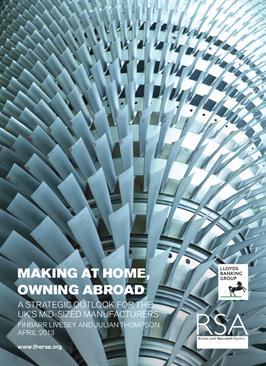Supported by Lloyds Banking Group, the report argues that a convergence of global trends will make global manufacturing uneconomic and unattractive to many businesses.
These trends include rising resource costs, increasing regulations on emissions, new production technologies and changing patterns of demand. Mid-sized companies will not be, in the long run, exporting at high volume, the report concludes. Instead they will be producing more in the country of use or very close to it, and owning productive assets abroad.
For a variety of reasons, mid-sized manufacturers are well placed to capitalise on this phenomenon. The report warns, however, that mid-sized companies have been overlooked and neglected by government, financiers and the media. It says that the road to their success is “a difficult one”, and it is unclear that the UK is ready to respond to the challenges and the opportunities that this changing context provides.
Recommendations for mid-sized manufacturing companies:
-
Increase exports in the short-term to increase market access, turnover and international experience.
-
Investment in new production technologies at the appropriate time to adapt to localisation pressures
-
Ownership or control of productive assets overseas in the medium-term to maintain market access.
-
Strengthening of management capability.
-
Work to improve the retention of highly-skilled employees.
Recommendations for government:
-
Continuation of actions to reduce uncertainty for manufacturing companies.
-
Support for mid-sized companies to access the Catapults,1 specifically the High Value Manufacturing Catapult, at reasonable cost.
-
Adaptation of the Small Business Research Initiative (SBRI) to target mid-sized manufacturing companies.
-
Helping to fix the skills shortage problem, through work on the image of manufacturing and the ongoing Foresight project on the Future of Manufacturing.
-
Include localised production in future analysis around the production and supply of energy.
-
Clarity on inward investment rules based on a strategy for development of more localised production in the long term.
-
Support for mid-sized companies moving to invest in production abroad to replace export footprints.
Recommendations for supporting organisations:
-
Lenders should understand the changing investment needs of manufacturing companies and be prepared to support international acquisitions.
-
Media representation of manufacturing should reflect the reality of the changing nature of manufacturing and the potential localisation that will occur.
-
Development of open innovation prize challenges to spur the development of new production technologies and infrastructure at a local and regional level.
-
Universities and professional bodies associated with engineering and manufacturing should support the development of degrees aligned with the medium to long term context of regionalisation and localisation.
pdf 10.1 MB
Contributors



Be the first to write a comment
Comments
Please login to post a comment or reply
Don't have an account? Click here to register.